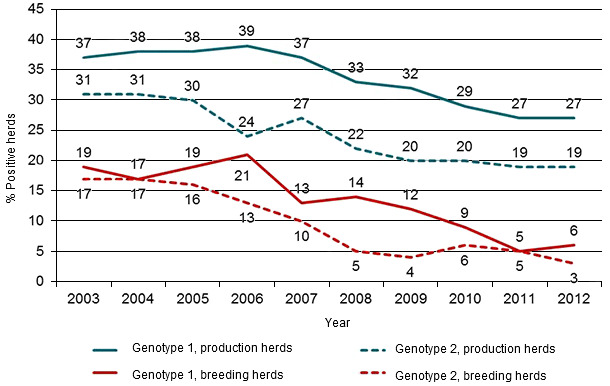Porcine reproductive and respiratory syndrome virus (PRRSV) is widespread and endemic in most European countries. To gather more information on the distribution of PRRSV, the cost of PRRSV and the handling of PRRSV in Europe, a short questionnaire was mailed to persons working with PRRSV in 20 EU countries. Based on the responses to the questionnaire and on a final report from an EU cost-action (EuroPRRSnet COST action FA0902, October 2013), this article was written. Thus it covers the PRRSV situation in and experiences from Denmark, Norway, Sweden, Finland, Switzerland, Germany, Holland, Austria, Poland, Italy, Spain, Greece, Romania, Coratia, Belgium and Ireland.
In Europe, only 4 countries have a PRRSV free status: Norway, Sweden, Finland and Switzerland. PRRSV genotype 1 (EU strain) is the most prevalent and only serotype in most countries, whereas genotype 2 (US strain) have a significant prevalence in e.g. Denmark, Germany, Austria and Poland. Due to a general lack of systematic surveillance in most countries, the true prevalence of PRRSV infected herds is unknown, but based on estimations it is expected to be 25-50% in e.g. Denmark and Romania, 50-75% in e.g. Germany, Greece and Austria and 80-95% in e.g. Italy and Spain.

The cost of the PRRSV infection in Europe seems not to be very well estimated in most countries. Studies in sow herds that experience acute PRRSV problems have shown a loss of 59 to 379 €/sow during outbreak in Holland (median 75 €) (Nieuwenhuis, Duinhof, and van Nes, 2012) and of 4 to 95 €/sow in Denmark (median 44 €). When comparing a large number of PRRSV chronically infected herds to non-infected herds, a Danish study showed only a marginally reduction in productivity (Sonne Kristensen and Vinther, 2013). The piglet mortality was 0.8-0.9 %-point higher and the nursery mortality was 0.4%-point higher in PRRSV infected herds. No difference was seen in mortality among finishers.
Only the four PRRSV free countries have a national control strategy. For these countries stamping out (total depop/repop) of infected herds are mostly used. In Sweden and in Switzerland PRRSV was diagnosed for the first time in 2007 and 2012, respectively. How PRRSV was spread to Sweden is unknown, but in Switzerland it was due to import of infected semen. After a relevant screening, all infected herds were culled and both countries regained PRRSV free status in less than a year.
In most EU countries the main measures of controlling PRRSV is by vaccination, change of management and by herd closure in combination with vaccination. Based on a high level of non-infected nucleus & multiplying herds in Denmark (90% of the herds are PRRSV free) that ensure a reliable and safe source for PRRS free replacement stock, PRRSV is eliminated by total depop/repop or by partial depop/repop to some larger extent in Denmark. Thus the prevalence of PRRSV infected herds in Denmark has been declining for more than 10 years.

Fig 1 – Development in the number of PRRSV positive breeding herds (nucleus and multiplying herds) and in the number of positive production herds in the Danish SPF system where all herds have a PRRSV declaration.
Apparently only a few EU countries, Holland and Denmark, are discussing national eradication as a possibility. In Holland a pilot program has been running for some years in a local area with a group of motivated farmers. All farms are tested 3 times a year and regular meetings are held to promote a voluntary eradication approach. In Denmark the most likely national cost of PRRSV has been calculated to be around 15 million Euro per year (Sonne Kristensen, 2015), whereas cost of a national eradication program running over a 5 year period, has been estimated to 120 million Euro. This gives a pay-back-time of around 15 years. Based on this the most probable strategy in Denmark (under discussion) will be a voluntary monitoring program for all herds, followed by an individual control plan for all herds, which eventually might lower the prevalence of infected farms.
Additional information may be found accessing the results of a PRRS survey funded by PRRS COST-action FA092.






